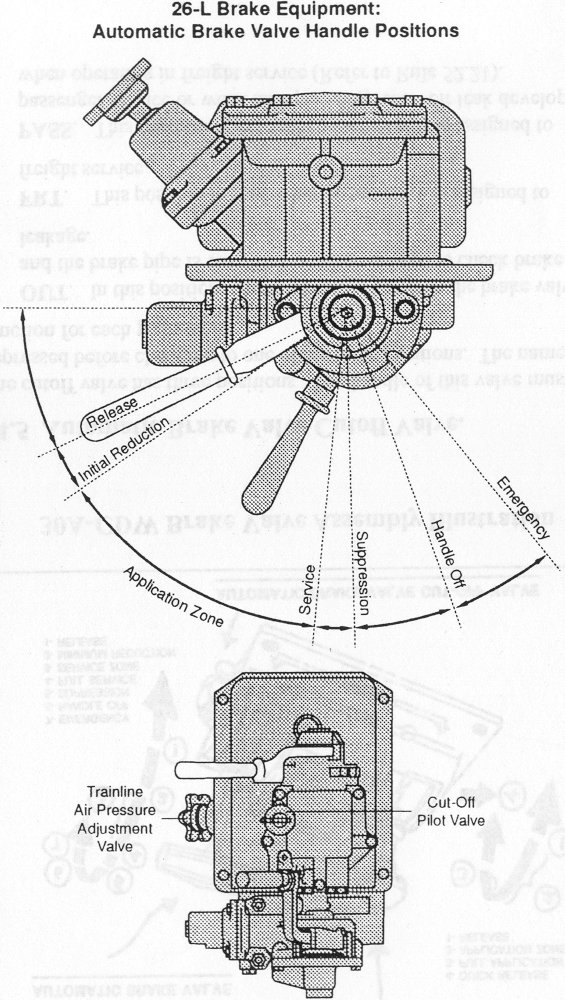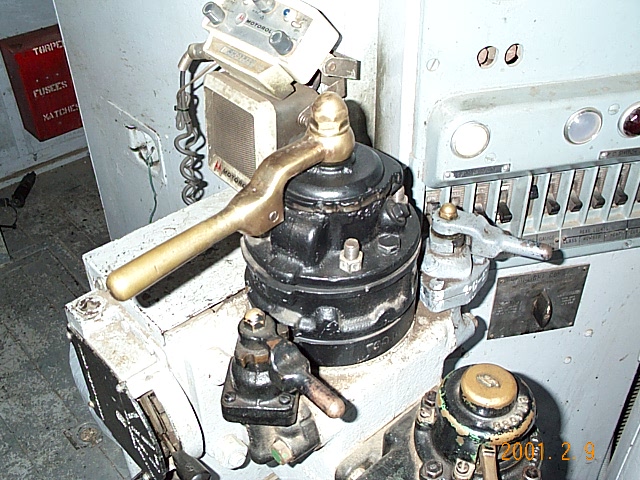Hey first time poster here,
I'm curious if somebody could explain the differences in locomotive braking systems and why some are not compatible with others. The example I had in mind was that of the DTSL GPs and how they could not operate with GTW units after the take over. In my non-railroader mind, air is just air and it should all be the same but obviously that isn't true. As a follow up, if the locomotive air systems cannot work together, how come they can both be connected to the same rail cars?
Thanks in advance
Brake Systems
- Erroneous Monk
- Railroadfan...fan
- Posts: 104
- Joined: Sat Dec 30, 2023 1:35 pm
- Location: The Water Tower
- SD80MAC
- Ingersoll's Mr. Michigan
- Posts: 10473
- Joined: Thu Mar 10, 2005 4:59 pm
- Location: Grand Rapids
Re: Brake Systems
Welcome to railroadfan.com. The most common air brake stands in the steam era were 6L (or 6SL on switchers) and 14L. These air brake configurations were carried over onto many early diesels. The DTSL GP7s had (I believe) 14L air brakes, while GTW's units used 26L or 24RL. 26L would eventually become the standard air brake by the early 1960s, as it featured self-lapping and pressure maintaining (many of the earlier systems did not maintain pressure in the brake pipe).
To put it into layman's terms, older systems like 6, 14, 24 etc do not self-lap, they have to be manually lapped. What this means is when the engineer moves the brake handle into the "service" zone to make a brake pipe reduction (to apply the brakes), the brake pipe would continue to exhaust until the brakes were fully applied until the engineer moved the handle back to the "lap" position. Newer brakes like 26, 30 etc do this automatically. The engineer only needs to move the brake handle to wherever in the service zone he wants and leave it there, the brake will stop applying until he decides he wants to set more air.
99% of locomotives (aside from some smaller GE switchers) have cut-out valves for their brakes. This allows the locomotive to be moved in a train regardless of its brake system. A unit with 24 brakes can simply be cut out and used behind a unit with 26 brakes, for example. The GTW had many Geeps equipped with both systems. Some of their earlier units with 26 air had special cut out valves that allowed them to be used in trail behind units with 24 or 6 air, too. Ok, so big deal, right? Just cut out the engines with the older air brakes and run them like normal behind units with new brake systems. Well, there's a bit more to it than that.
The most important part of setting up a consist of locomotives is braking. Yes, in theory any locomotive can have their brakes completely cut out and set up as a "boxcar", meaning their brakes will apply and release like any other car in the train, but this is not ideal. Locomotives tend to "set up" much quicker and harder than freight cars, which can lead to locked wheels and subsequently, flat spots. Locomotive brakes differ from train line brakes in that they are induction systems, rather than reduction systems. Air is applied to the system to make the locomotive brakes apply, instead of removed. Ideally, you want 26 equipped units running with other 26 equipped units for uniform braking. 24 units (24 is basically a road version of 6, that allows for multiple unit operation and standard locomotive consist braking) can be used behind 26 units, but there are so many variations of 24 that it is not always guaranteed to work right. Having every locomotive apply and release in concert is very important. When the engineer applies the train brakes, he will "bail off" the locomotive brakes, so the engines are coasting while the train is doing the braking. This keeps the slack on the train from running in, and reduces wear on the locomotive brake shoes. You basically don't ever want to touch the locomotive brake unless you are almost stopped, or you're switching.
Getting back to your original question, the DTSL GP7s used a unique version of 14 air brakes that were not compatible with anything else but that same version of 14, something no other GTW units had. After acquiring the DTSL, GTW elected to rebuild 2 of them (46 and 49, becoming 6046 and 6049) to GP9 specs and 26 air. The rest were retired and sold off with the oddball 14 air. In order for them to be moved in a train with other locomotives, they had to be completely cut out. By the mid 1980s, GP7s were considered obsolete, and the GTW saw no reason to update them all.

Diagram of 26 air

Typical 6 air brake stand
To put it into layman's terms, older systems like 6, 14, 24 etc do not self-lap, they have to be manually lapped. What this means is when the engineer moves the brake handle into the "service" zone to make a brake pipe reduction (to apply the brakes), the brake pipe would continue to exhaust until the brakes were fully applied until the engineer moved the handle back to the "lap" position. Newer brakes like 26, 30 etc do this automatically. The engineer only needs to move the brake handle to wherever in the service zone he wants and leave it there, the brake will stop applying until he decides he wants to set more air.
99% of locomotives (aside from some smaller GE switchers) have cut-out valves for their brakes. This allows the locomotive to be moved in a train regardless of its brake system. A unit with 24 brakes can simply be cut out and used behind a unit with 26 brakes, for example. The GTW had many Geeps equipped with both systems. Some of their earlier units with 26 air had special cut out valves that allowed them to be used in trail behind units with 24 or 6 air, too. Ok, so big deal, right? Just cut out the engines with the older air brakes and run them like normal behind units with new brake systems. Well, there's a bit more to it than that.
The most important part of setting up a consist of locomotives is braking. Yes, in theory any locomotive can have their brakes completely cut out and set up as a "boxcar", meaning their brakes will apply and release like any other car in the train, but this is not ideal. Locomotives tend to "set up" much quicker and harder than freight cars, which can lead to locked wheels and subsequently, flat spots. Locomotive brakes differ from train line brakes in that they are induction systems, rather than reduction systems. Air is applied to the system to make the locomotive brakes apply, instead of removed. Ideally, you want 26 equipped units running with other 26 equipped units for uniform braking. 24 units (24 is basically a road version of 6, that allows for multiple unit operation and standard locomotive consist braking) can be used behind 26 units, but there are so many variations of 24 that it is not always guaranteed to work right. Having every locomotive apply and release in concert is very important. When the engineer applies the train brakes, he will "bail off" the locomotive brakes, so the engines are coasting while the train is doing the braking. This keeps the slack on the train from running in, and reduces wear on the locomotive brake shoes. You basically don't ever want to touch the locomotive brake unless you are almost stopped, or you're switching.
Getting back to your original question, the DTSL GP7s used a unique version of 14 air brakes that were not compatible with anything else but that same version of 14, something no other GTW units had. After acquiring the DTSL, GTW elected to rebuild 2 of them (46 and 49, becoming 6046 and 6049) to GP9 specs and 26 air. The rest were retired and sold off with the oddball 14 air. In order for them to be moved in a train with other locomotives, they had to be completely cut out. By the mid 1980s, GP7s were considered obsolete, and the GTW saw no reason to update them all.

Diagram of 26 air

Typical 6 air brake stand
"Remember, 4 mph is a couple, 5's a collision!"
http://flickriver.com/photos/conrail680 ... teresting/

http://flickriver.com/photos/conrail680 ... teresting/

- Saturnalia
- Authority on Cat
- Posts: 15396
- Joined: Wed Sep 28, 2011 7:54 pm
- Location: Michigan City, IN
- Contact:
Re: Brake Systems
Thanks for the write-up Jon, learned a lot I had wondered before.
- Erroneous Monk
- Railroadfan...fan
- Posts: 104
- Joined: Sat Dec 30, 2023 1:35 pm
- Location: The Water Tower
Re: Brake Systems
Yes, thanks for such a detailed explanation, it really clears up my understanding of this.
So, if I have it right, on older braking systems where you put the brake lever only really changes how fast the brakes are applied to 100% whereas on newer systems, where the lever is placed dictates the total percentage of braking applied by the locomotive?
So, if I have it right, on older braking systems where you put the brake lever only really changes how fast the brakes are applied to 100% whereas on newer systems, where the lever is placed dictates the total percentage of braking applied by the locomotive?
- SD80MAC
- Ingersoll's Mr. Michigan
- Posts: 10473
- Joined: Thu Mar 10, 2005 4:59 pm
- Location: Grand Rapids
Re: Brake Systems
More or less. On an older brake like a 6, 14, or 24, if you move the handle to service, it’s like moving it to 100%. The pipe is going to keep exhausting until you move it back to lap. On newer brakes like 24, you can move the handle just a touch off of “release”, and you’ll take a minimum reduction, 4 or 5 lbs at most.
"Remember, 4 mph is a couple, 5's a collision!"
http://flickriver.com/photos/conrail680 ... teresting/

http://flickriver.com/photos/conrail680 ... teresting/

